President's Message
While the current news covered by the media seems to be distressing most of the time, it is refreshing to know there are also positive things happening. Actually we have much for which to be thankful.
We have been giving up-to-date reports since the construction began on building a replica 19th century kitchen for Meadow Farm Museum, a project Friends of Meadow Farm and the Henrico County Historical Society have been working for some time so that a more complete history of the historic site can be presented.
We are pleased to announce the kitchen is completed and will be officially dedicated in September. It was open for a preview at the 4th of July celebration held at Meadow Farm this year.
One has only to review the list of organizations and to consider the individuals within those organizations, especially our own members, who gave freely of their time, talents, and contributions, to see this project has truly been a community effort.
First and foremost, we would like to thank our volunteer project manager, John Hoogakker, whose tireless efforts were instrumental in making this project a reality.
We would like to extend heartfelt appreciation to the following contributors:
- Colonial Dance Club of Richmond
- 12th Virginia Infantry Company B
- Living History Reenactors
- Virginia Homespun Dance Ensemble
- Henrico Concert Band
- UDC - General Stuart Chapter
- The Enrichmond Foundation
- The University of Richmond
- Wolf Creek Cherokee Tribe of Virginia, Inc., Chief Terry Price and his wife Annette
- Kiwanis Club of North Richmond
- Mr. Ralph Higgins for his artistic rendition of the proposed kitchen
We also received memorial contributions as requested by the family in the name
of "Kelly" Ault (a dedicated volunteer at Meadow Farm) as well as other memorial donations.
We are grateful to the following charitable organizations for their generous contributions and grants for this project and for their good works within the community:
- Mary Morton Parsons Foundation
- The Cabell Foundation
- Weinstein Properties, Marcus Weinstein, Chairman
- Honey Foundation, LLC, Bobby Ukrop, Director
- Association for the Preservation of Henrico Antiquities, Dr. Henry Nelson, President
As well, we appreciate the support of the Henrico County Board of Supervisors, the Henrico County Manager and the Henrico County Division of Recreation and Parks. Most especially, we appreciate the interest and support of Supervisor Dan Schmitt of the Brookland District.
Job well done by all!
Sarah Pace
President
>Back to Top<
September Quarterly Meeting

Our September meeting will be on Sunday, September 11th, starting at 2:30pm. The location is Henrico County Recreation and Parks, which is located at 56800 Staples Mill Road in Henrico, VA 23228.
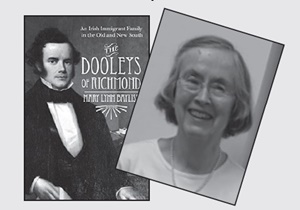
Our speaker will be Mary Lynn Bayliss, the author of The Dooleys of Richmond.
A tour of the archival facilities will follow.
We look forward to seeing you there!
>Back to Top<
Field Trip: Belle Grove Plantation
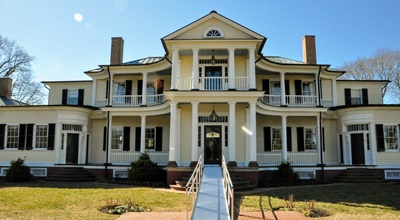
Join us for a tea and a tour of Belle Grove Plantation!
Belle Grove is birthplace of President James Madison.
The field trip is scheduled for Sunday, October 23rd.
For details, visit www.henricohistoricalsociety.org/shopping.html.
>Back to Top<
It's Time to Get Cooking at Meadow Farm's Kitchen
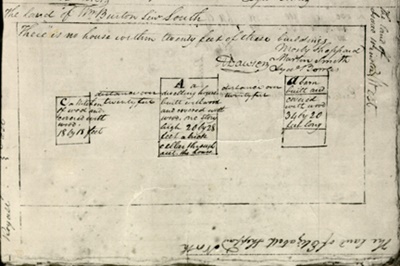
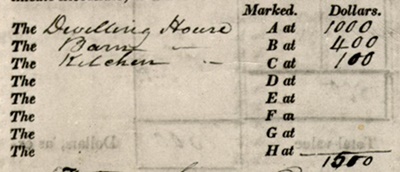
Mosby Sheppard's 1812 Mutual Assurance Society policy (2nd image left) locates the 18' x 18' kitchen building 25' to the east of the main house and estimates its replacement value at $100 (top image left). Recreating the kitchen in 2022 ran close to $335,000, and the September opening of the facility to the public will show that contributions from donors and matching funds from Henrico County were dollars well spent. Of course, the structure's centerpiece is the fireplace large enough for a person to lie down in and a flue wide enough for a person to climb up, resulting in an impressively large brick construction at the building's back.We look forward to seeing the fireplace in use and possibly tasting fare produced there.
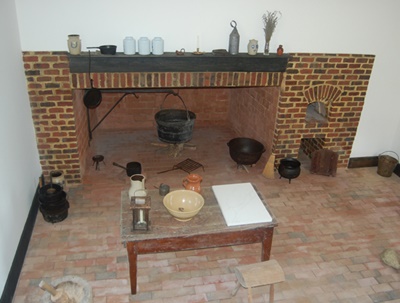
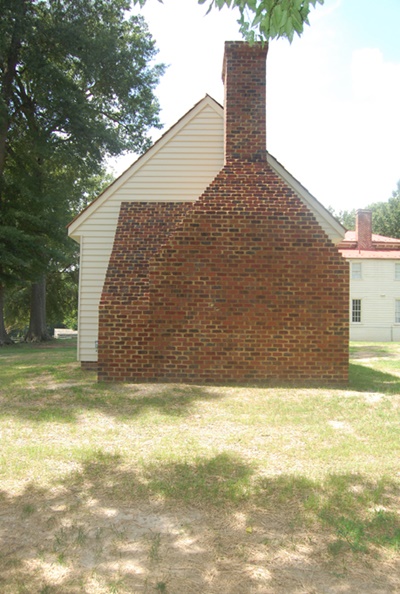
>Back to Top<
Inventive Henricoans
While some inventions amaze by their insight and intricacy, those like the carpenter's wood clamp by Charles L. Jones amaze by their beauty. His clamp is innovative with the detachable jaw, allowing for multiple adjustments depending on the slot the descending pegs were slipped into. But its real beauty lies in the aesthetics - the S-shaped braces on the two jaws and the sort of filigreed base. If only ordinary tools of today were so designed.
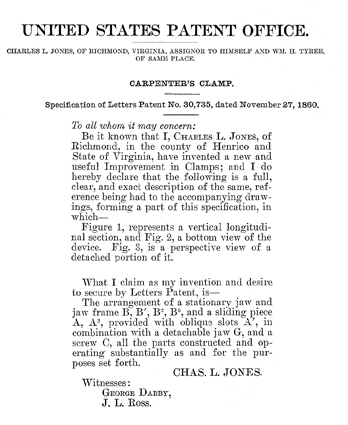
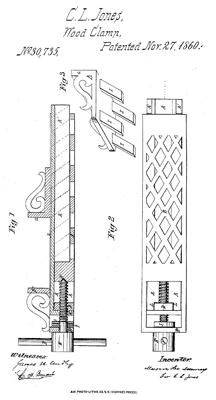
>Back to Top<
A Pear Tree Commemorates a Pairing

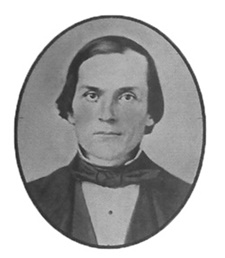
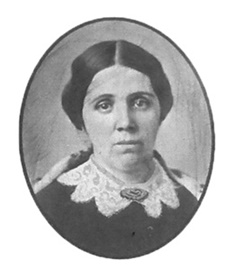
After his 13 August 1846 marriage to Virginia Anne Young, Dr. John W. Sheppard planted a pear tree at Meadow Farm to commemorate the occasion. According to Meadow Farm site manager Julian Charity, that tree still produces fruit. Logs serve as supporting props, and a fence now protects the venerable old tree from visitors tempted to climb it or perch children in it for pictures. Perhaps, pears that tree once produced might have been stewed or turned into marmalade as the recipes below from Mary Randolph's The Virginia Housewife describes.
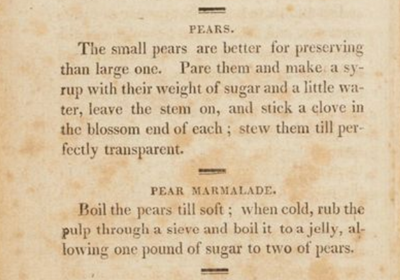
>Back to Top<
Improvements by The Brooke Turnpike Company Aimed to Put Folks On the Road Again
My father-in-law loved old roads. He had spent much of his working life traveling the roads of southwest Virginia for the DMV, and he knew all the twists and turns of all those main roads and back roads. Of course, roads change; and later, when he traveled with us, we couldn't pass barely noticeable gaps in the roadside vegetation without his noting, "That's where the old road used to go."
He was going southwest out of Richmond, and one of the oldest roads going north out of the city, Brook Road, has seen great changes in its two hundred years plus since Lafayette marched down it in 1781. And those big changes and reroutings have made it nearly impossible to tell "where the old road used to go."
So we'll start with where the old road began its life as a turnpike, one of the oldest in the state. On 4 February 1812, the General Assembly passed "An Act incorporating a Turnpike Road from the City of Richmond to Williamson's Tavern." Dabney Williamson's tavern "stood at the junction of the northern stage road and the road leading from Richmond to Louise Courthouse." It also authorized twelve managers who would receive and enter "subscriptions to the amount of twenty five thousand dollars for the undertaking, which sum shall be divided into five hundred shares, of fifty dollars each . . . in Virginia currency." It called for a road at least thirty feet wide, ditched on each side and covered with gravel or stone. It went on to establish the following tolls. A loaded wagon and team would pay twenty cents; carts and tumbrels were charged four cents per wheel; but only two cents per wheel was charged for carts carrying wood to Richmond. For horses, mules, horned and other cattle attached to carriages, a toll of two cents was charged. It seems that empty carts on return trips did not pay tolls, while those returning vehicles that had not used the turnpike did owe tolls. Even hogs and sheep required a half-cent toll.
Planning to organize a turnpike company, like so many other nineteenth century endeavors, began in a tavern sometime before June of 1812, when announcements in The Enquirer called for its stockholders to meet at the Bell Tavern at 11:00 a.m. on the 15th of June "on business interesting to them."
That tavern, located at what is now the intersection of Fifteenth and Main Streets just west of Main Street Station, was a busy spot in the early 1800s, serving as a recruiting station for the War of 1812 and many succeeding meetings of The Brooke Turnpike Company.
One item of great importance, of course, was underwriting the costs of the construction, and The Enquirer of 22 December 1812 shows us how the financial costs were to be covered. It notified stockholders "that ten dollars must be paid on each share to Carter B. Page, Treasurer, on or before the first Monday in January next, and two dolls [sic] and fifty cents on the first Monday in every succeeding month, during the year 1813." It also advised the directors of a meeting that seems to be one of the few tavern meetings related to the turnpike that occurred at a location other than The Bell. At that meeting on 28 December 1812 at Baker's Tavern at Bacon Quarter Branch, turnpike directors were to "receive proposals from those who may be disposed to undertake to complete said road." Baker's Tavern would later become Goddin's Tavern, which this newsletter featured in its June 2018 issue.
Treasurer Carter Page and Benjamin Sheppard, the owner of Brookfield, were soon apparently spearheading the project and were ready to start. To get underway, they placed an advertisement in the 7 January Enquirer indicating their desire of "purchasing twenty Mules, and of hiring for the ensuing year, twelve Boys & twenty Men" and to engage two overseers to "superintend the making of the road."
But it looked as if the project was off to a rocky start because just a year later, it seems that the company was in trouble - or, at least, the directors wanted the stockholders to think so. On 19 January 1813, the directors took out an announcement in the Enquirer asking the stockholders to attend a meeting at Bell Tavern "to take into consideration a dissolution of said company." It makes reference to "excessive damages assessed by the Jury" and claims it be impossible "with the present capital to complete said road."
The situation, as well as its possible cause, seems unclear; and it could lead one to suspect an alarm hoping to spur stockholders, who from other announcements in other papers seem to have often been delinquent, to provide funds necessary to the road's completion. At any rate, whatever the problem was, it seems to have been quickly overcome because in the 22 October 1813 Enquirer, Benjamin Sheppard indicated his desire "to hire six Carts, with two horses or mules each and a driver, to haul gravel on the Brooke Turnpike Road."
And within eight months, the turnpike literally passed a milestone. The General Assembly had stipulated that once the road was two-thirds finished, tolls could be collected. The 1 June 1814 Enquirer carried a notice that "Tolls will commence on Friday next, and be demanded by all persons traveling said road, as apportioned by law."
Those tolls were apparently prorated since the project had not reached completion; however, by late October of the same year, the work was finished. Governor James Barbour's name appears over the 28 October 1814 Enquirer announcement that "the whole road has been completed," and that "The President and Directors of the said Company are therefore authorised to demand & receive full Toll."
Even before the completion of the road, plans were being made for extending it. On 17 August 1814, the Enquirer ran "a petition to the General Assembly for "leave to incorporate a company to turnpike the road from the end of the Brook Turnpike to Taylor's Mill, Hanover and from thence to Fredericksburg." The company would not be the Brooke Turnpike Company, because it appears that Benjamin Sheppard, "By order of the Directors" was selling off its tools, livestock and equipment. In the 8 December 1814 Enquirer, he announced the sale of "fifteen large likely, young, well-bred mules, seven or eight tumbrels and geer [sic], fifteen or twenty pole axes, from twenty to thirty spades, twenty mattaxes and pecks[sic]."
The Brooke Turnpike Company's construction work was done, and it was time to pay dividends to stockholders. And the investment in the stock, according to regular announcements in the papers up through 1825, paid dividends of three to five percent every six months. Of course, acquiring the funds to meet those dividends required that tolls be regularly collected, and tolls had not always been collected immediately. Through toll gatherer Robert Priddy, the Directors ran an announcement in the Richmond Enquirer on 3 February 1820 stating, "Notice is hereby given that from the 15th day of February next, no credit will be given for tolls to any person on the Brook turnpike road; nor will any accounts for tolls be kept after that date. All persons indebted for tolls are required to settle their accounts without delay."
The road did apparently improve travel to and from Richmond. When J. Walker announced that he was erecting a building to be rented as a tavern on the turnpike in the 16 December 1824 Richmond Enquirer, he touted "the vast deal of traveling on this, the greatest road in Virginia."
And if we listen to Benjamin Sheppard's claim, travel time was reduced. When he put Brookfield up for sale in 1827, his 11 September Richmond Enquirer advertisement under the heading "Brookfield for Sale" indicated that from his residence, "it is only half or three quarters of an hour's ride, and on one of the best Turnpikes in Virginia." However, Brookfield didn't sell immediately; and four years later he tried selling it again. This time his 10 November Constitutional Whig ad indicated that it "is sufficiently near the City of Richmond . . . not more than one hour's ride."
However much it reduced travel time or however much traffic it carried, the turnpike seems to have gradually deteriorated until in 1890 when Lewis Ginter bought controlling interest in the Brooke Turnpike Company. A lengthy obituary for him in the 5 October 1897 Roanoke Times cites his many endeavors, including his transformation of the road. It said: "The Brook turnpike, at one time one of the dreariest and roughest highways that ever lead to the heart of a large city was transformed by his munificence into six miles of beautiful granitized road, as smooth and durable as the streets of many cities."
Of course, the Brooke Turnpike Company is no longer, and Brook Road has been rerouted, joined to Route 1 and no longer resembles the road of two centuries ago. If my father-in-law still ride on Brook Road, he couldn't tell me, "That's where the old road used to go."
Joey Boehling
Brooke Turnpike Toll House. Dating prior to 1840, it is one of the few surviving nineteenth century toll houses in the state. The turnpike originally ran a few feet from the front porch. The roadbed was moved and later abandoned. The new roadbed eventually became Route 1. The toll house is on private property, part of historic Brookfield.
Photo by Chuck Peple from the History of Henrico County
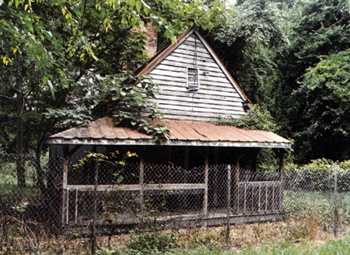
Where it all began. The original site of the Bell Tavern at Fifteenth and Main today lies under I-95 just west of Main Street Station, seen in the background. Meetings for the Brooke Turnpike Company's stockholders were regularly held there. The marker for the tavern is set in the wall just to the left of the first concrete support column. It is partially obscured by an electrical box on the sidewalk in front of it.
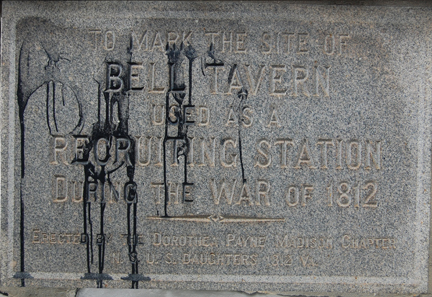
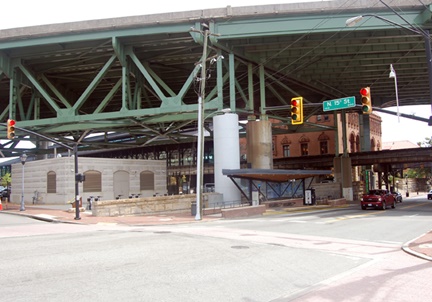
Getting started. The 9 November 1812 Virginia Argus announces the organizational meeting of the Brook Turnpike Company at the Bell Tavern.
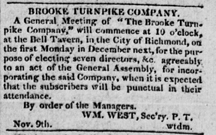
Brooke Turnpike Route. The two circles on this detail from the 1864 Smith Map of Henrico County mark the location of the Toll Gate just outside of Richmond and tavern at the intersection where the turnpike ended.
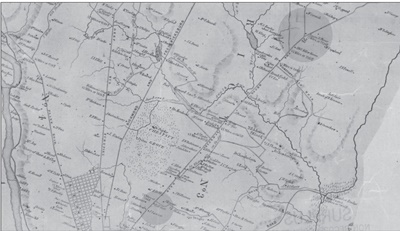
>Back to Top<
Now You Know: Art Deco Styling in Oral Hygiene
We congratulate Mary Jo and Haywood Wigglesworth and Jim DuPriest who correctly identified the "What Do You Know?" object from the last newsletter as a ceramic toothbrush holder. However, they did not recognize its additional function as a brush sterilizer. It was a 1930s product of the Lambert Pharmacal Company, the makers of Listerine; and its central well was meant to be filled with the product for immersing the bushes.
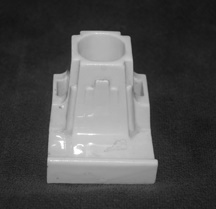
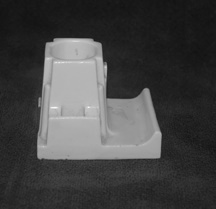
Named after Joseph Lister, the first to perform antiseptic surgery, Listerine was formulated in St. Louis, Missouri in 1879 by Dr. Joseph Lawrence and Jordan Wheat Lambert, a Randolph-Macon College graduate.
The toothbrushes that went into the holder have an older history, dating back at least to 3000 B.C. when people used frayed sticks called chew sticks to rub against their teeth. The bristle toothbrush dates back to 1498 in China. The bristles were actually the stiff, coarse hairs taken from the back of a hog's neck and attached to handles made of bone or bamboo.
William Addis, an Englishman, was the first to mass produce toothbrushes around 1780; and the first American to patent a toothbrush was H. N. Wadsworth on 7 November 1857. Boar bristles were used until 1938, when Dupont de Nemours introduced nylon bristles. The first nylon toothbrush was called Doctor West's Miracle Toothbrush.
Keeping 'em clean. Instructions on the bottom of the toothbrush sterilizer tell the user to "Fill with Listerine and dip brush before using."
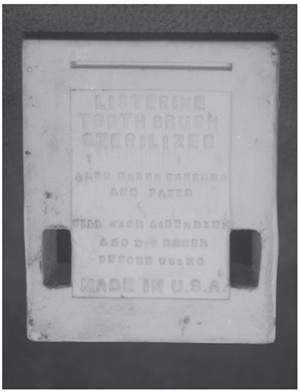
America's first. H. N. Wadsworth's illustration accompanied his 1857 patent, the first American toothbrush.
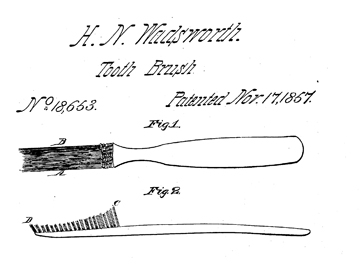
Brushes from three ages. From left to right at the bottom are a chew-stick, a Victorian toothbrush with a sterling silver handle and a bone and bristle toothbrush from the 1930s.
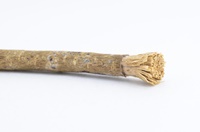
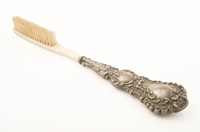
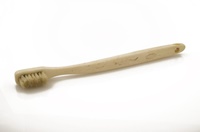
>Back to Top<
What Do You Know?
The glass container of this item is 11" long and 6" inches in diameter. There is a funnel-shaped opening in one end and a perforated screw-top lid on the other end.

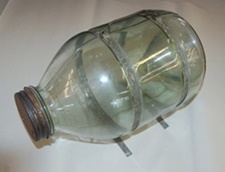
Do you know what it is?
Email your answer to jboehling@verizon.net.
>Back to Top<
News 2022: Third Quarter
First Quarter | Second Quarter | Fourth Quarter
Home | Henrico | Maps | Genealogy | Preservation | Membership | Shopping | HCHS
|











